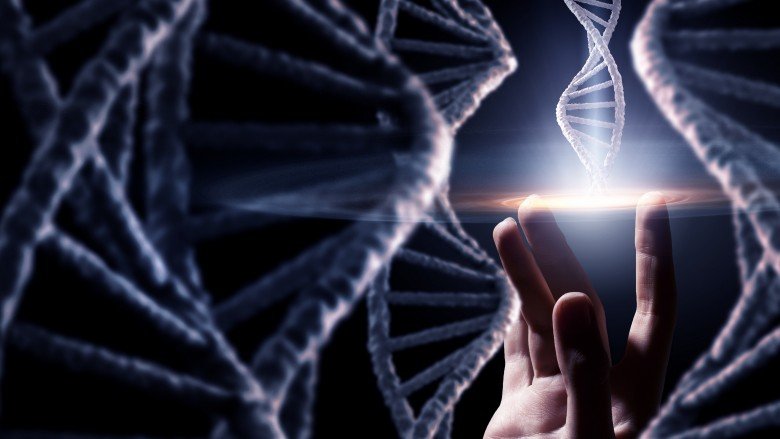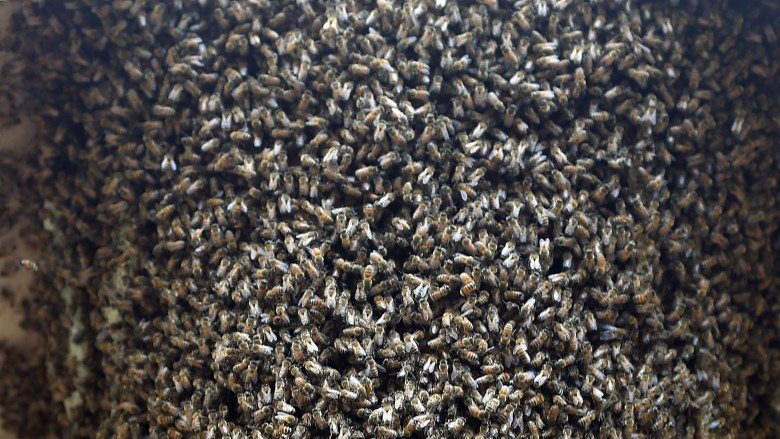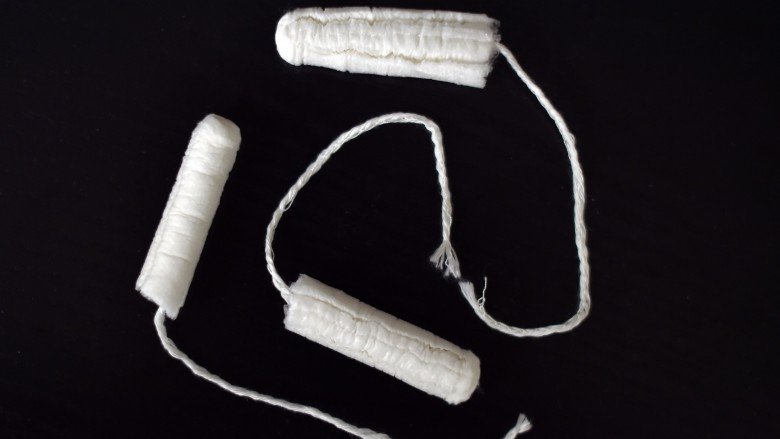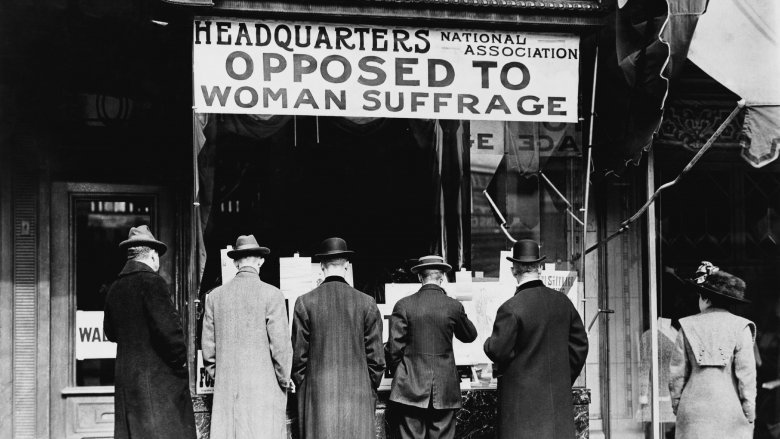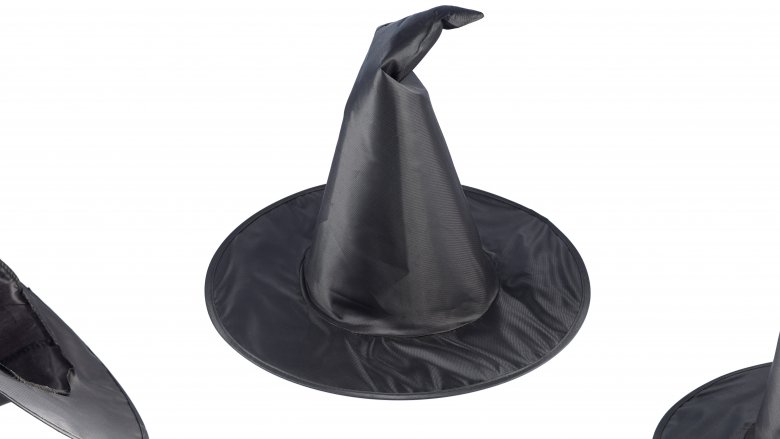Things People Used To Believe About Women's Bodies
People used to believe a lot of things that now seem completely bizarre to us, thanks to modern science. Most people today would scoff at someone saying the earth is flat or that everything in the universe revolves around it, even though that's what most people believed just a few centuries ago. People today also know that bloodletting is not a good healthcare practice, that there is no secret process with which to create the philosopher's stone, and that smoking is terrible for your health.
Some of the strangest beliefs, however, revolved around some truly outlandish things about women and their bodies. Many of these beliefs stemmed from superstition and the patriarchal concept of women being naturally inferior to men. While science still hasn't proven all the mysteries of the universe, it has definitely debunked all of these old-fashioned theories!
Menstruating women can kill swarms of bees
Ancient Roman author, philosopher, and naturalist Pliny the Elder compiled an encyclopedia, titled Natural History, in which he devoted a section to the various "powers" that menstruating women allegedly possess.
As Pliny believed, a woman on her period is a force to be reckoned with. Side effects of a woman's time of the month include cursing plants in her path, dimming the "brightness of mirrors," driving dogs crazy, and killing swarms of bees. According to his writings, iron would rust, ivory would lose its polish, and steel blades would be made blunt. If a woman's menstrual fluid somehow was exposed to lightning during a thunderstorm, the storm would be driven away by the power of the woman's flow.
Women have fewer teeth than men
It wasn't just the ancient Romans who held unflattering views of women. The ancient Greek philosopher and scientist, Aristotle, has had a huge impact on Western philosophy. While hailed as a great thinker and teacher, his views on women were more than a little problematic.
For a man regarded as a scientist, Aristotle had some pretty unscientific views about women. A woman was believed by Aristotle to be an "incomplete" version of a man, and even had fewer teeth than their male counterparts.
According to Aristotle's social hierarchy, women were ranked higher than slaves, but below men. In Politics, the philosopher argued that men are superior as they possess "intellectual virtue in completeness." Women, according to Aristotle, were meant to serve men because they were physically and intellectually inferior to them.
Women have wandering wombs
Another ancient Greek, the physician Hippocrates, deserves the credit for identifying the "disorder" of hysteria. The term "hysteria" was a catch-all phrase that described pretty much anything that went awry with a woman's mental or physical health. The cause? A "wandering uterus."
For centuries, people believed that a woman's womb roamed all over her body like a living parasite. Aristotle used the diagnosis of hysteria to further discredit women. Yet another ancient Greek, Aretaeus of Cappadocia said that the womb is "closely resembling an animal" and "moves itself hither and thither." Even after people understood more about the human body and its functions, hysteria continued to be used as a diagnosis.
Women don't have sexual urges
The idea of hysteria persisted through the Victorian Age. Sex during this time was such a taboo topic that it seems like people went out of their way to deny that it was anything but a mechanical process. While men might indulge their sexual urges, such desires in women were considered to be low class. Sex was a burden that women were meant to endure, not enjoy. A popular (though fictional) anecdote has Queen Victoria advising one of her daughters that on her wedding night she should "lie back and think of England."
Self-pleasure leads to being flat-chested
In the Victorian era, masturbation was a huge no-no. Some of the myths about touching yourself down there are still spread as old wives' tales. People today don't really believe that the practice will drive you insane, or make you grow hair on your hands, though these rumors still persist.
But back in the Victorian era, however, people thought that stimulating oneself was not only immoral but could lead to developmental delays, such as girls being flat-chested. John Cowan wrote in The Science of a New Life that "girls who have followed masturbating habits...show usually strong indications of it in the failure of their glandular development. Such persons are apt to be flat-breasted, or, as we term it, flat-chested."
Myths about the harms of solo-sex were so pervasive that people went to great lengths to prevent their children from touching their private parts. Devices were marketed to prevent masturbation, and doctors even performed clitoridectomies on young girls to prevent the practice.
Reading makes women infertile
In contrast to modern women who tend to outnumber men in universities in much of the world, it was once thought that women who read too much would be rendered infertile. This theory was widely spread by a Harvard professor named Edward H. Clarke who wrote in Sex in Education, or A Fair Chance For The Girls that, while women are capable of learning, too much book learning could lead to infertility and irritability. Clarke recommended that girls receive limited schooling so as not to damage their health or baby-making abilities.
Thankfully, well-educated women took it upon themselves to disprove Clarke's theories. An 1885 study by Annie Howes, of the Association of Collegiate Alumnae, and an 1887 paper by Mary Putnam Jacobi, debunked Clarke's treatise.
Viewing ugly things while pregnant makes ugly babies
In the 18th century, many people thought that the things a woman thought could affect what her baby looked like. In The Pregnant Imagination, Fetal Rights, and Women's Bodies: A Historical Inquiry, Julia Epstein writes that there was a debate over whether or not "imaginative activity in the minds of pregnant women could explain birthmarks and birth malformations."
Many people thought that a woman could directly influence the appearance of her child and that looking at unattractive things could cause the child to be born, well, unattractive. It was widely recommended that women avoid "unwholesome" things, lest they deform their developing child.
A woman on her period is unclean
The idea that a woman on her period is somehow unclean dates back to antiquity. According to the book of Leviticus in the Bible, not only was a woman on her period unclean, but so was everything she wore and touched. The thirteenth century De Secretis Mulierum (The Secrets of Women) was written by a man claiming to be a monk, Albertus Magnus. According to Magnus, "Menstrual matter is extremely venomous" and a woman on her period gives off "fumes" which can poison children.
These ideas persisted in Western culture through the 20th century, well past the point you'd think people would have dismissed such clearly irrational thinking. In the 1920s, a doctor named Bela Schick described "menotoxin," an alleged "menstrual toxin" that was secreted in a menstruating woman's sweat and had the power to cause flowers to wilt. Other "studies" claimed that menotoxin in breast milk caused colic in infants and that a woman who was "menotoxic" during pregnancy gave her baby asthma.
Tampons can make women lose their virginity
This myth is still getting some traction, even though there is no truth to it. When Tampax was introduced in the 1930s, many people thought that they shouldn't be used by young girls. The main fear of moral conservatives was that inserting a tampon would result in the loss of virginity.
Consumer Reports released an article in the 1940s telling people that it was okay for virgins to use tampons. In case there's still any confusion, the only thing that can make someone lose their virginity is actually having sex.
Only willing women can get pregnant
This myth is particularly terrifying, in that many people still believe it. In 2012, Missouri Congressman Todd Akin claimed that rape victims can't get pregnant since in a "legitimate rape, the female body has ways to try to shut the whole thing down."
Akin isn't the only modern politician to have expressed that idea. In 1995, North Carolina state representative Henry Aldridge, said that women "who are truly raped" cannot conceive a child as "the juices don't flow" and "the body functions don't work." In 1998, Republican Senate candidate Fay Boozman said that stress of assault will trigger a biochemical response in rape victims that makes conception next to impossible. Pennsylvania state legislator Stephen Freind claimed in 1988 that the odds of a rape victim becoming pregnant were "one in millions and millions and millions."
The impossibility of rape leading to conception has been used as a legal defense since at least the 13th century. Vanessa Heggie, a historian at the University of Birmingham, wrote in a blog piece for The Guardian that Fleta, a British legal text from that time period, says "without a woman's consent she could not conceive."
Women's brains are smaller and less capable
Women fought a long and arduous battle to win the right to vote. It wasn't until 1920 that women in the United States were allowed to cast a ballot, and Switzerland's women couldn't vote until 1971.
One of the reasons given for not allowing women to vote was that their smaller brains made them mentally inferior to men. Members of anti-suffragist movements such as the National Association Opposed to Women's Suffrage (NAOWS) claimed that women did not have the capacity to understand politics and therefore should not be given the right to vote. This idea was so accepted that even women believed it and joined anti-suffragist groups, lending some credibility to a claim on a pamphlet issued by the NAOWS that most women had no interest on how the country was run.
Women's brains function just as well as men's brains. They are physically smaller on average, but this correlates to body size and has no impact on intelligence.
Female virgins can cure men with venereal diseases
A long-held belief that some people still have faith in is the idea that sleeping with a virgin will cure a person of a disease. There is, of course, no credence to this belief, but it has resulted in the abuse of countless young women throughout history.
People in England and the United States believed well into the twentieth century that sleeping with a young virgin would cure them of syphilis and other venereal diseases. The virgin's pure and untouched state was somehow thought to have restorative properties that would be transferred to the afflicted man. Even more alarming is the fact that many of the men who sought out young girls for such purposes believed that the disease would be cured in him but passed on to the girl.
In modern times, there are still men who believe in this myth. Men afflicted with AIDS in sub-Saharan Africa along with parts of India and Thailand have reportedly sought out young girls in search of this "cure."
Infertility is all the woman's fault
Women in ancient Egypt were generally viewed as equal to men, but that doesn't mean that their society understood how women's bodies worked. Ancient Egyptians were particularly perplexed by what made a woman fertile and assumed that a couple's ability to conceive rested solely on the woman. It was thought that women with wide hips and large breasts were more fertile than those with narrow hips and flatter chests.
In order to test a woman's fertility, a clove of garlic or an onion would be placed inside a woman's vagina. That belief was that if the woman was, fertile her uterus would be linked to her alimentary canal and her breath would smell like garlic or onion the next day. If the smell of garlic or onion didn't travel to her mouth, then the woman was blocked and would not be able to conceive. This particular fertility test was also utilized by the ancient Greeks.
Exercise is dangerous for women
Strenuous activity was thought to be dangerous for women as it could harm their reproductive parts. It was the general consensus of the Berlin Medical Association in the 19th century that the "ailing health" of women during menstruation and pregnancy was proof that they were the weaker (and therefore inferior) gender.
One 19th century German doctor strongly advised against girls jump-roping as "it made the feet flat, damaged the lungs, and caused twisting of the bowels as well as chronic headaches." A director of a 19th century gymnastics teachers training institute agreed that women should avoid "exercise which requires sudden and jerking movements... on account of the particular position of the female reproductive organs."
We still have work to do
It is scary to think about living in a time when the female body was so misunderstood. While women today have it much better than they did in the past, things are still far from perfect.
A recent global study showed that three out of four women believe their country has unequal rights. Nearly half of the women in the world say that they do not personally feel they have equal status to men. One in five people still believe that women are inferior to men.
We might live in a more enlightened time, but there is still work to be done.
Breast milk is coagulated menstrual blood
From ancient times through the Middle Ages, most people thought that breastfed babies were being given blood. The dominant belief in these times was that breast milk and menstrual blood are the same substance, but that breast milk "had been heated, coagulated, and whitened by hot air." This bizarre idea persisted for centuries and was taught by prominent philosophers including Aristotle and Galen, and can also be found in the Jewish Talmud.
The uterus has seven cells
Before people understood the science behind reproduction, they believed that a baby's sex depended on which chamber of the uterus it was carried in. It was commonly believed that the uterus had seven chambers or cells, with the right three developing males and the left three developing females. If a baby developed in the center cell, it would be intersex, having both male and female features. The concept of the seven-chambered uterus reigned throughout the Middle Ages and persisted long after anatomical dissection proved that there is only one space in the uterus.
Renaissance thinkers eventually replaced the debunked myth with even more ridiculous notions. They believed that the father's sperm turned the mother's menstrual blood into milk which also formed the fetus. In order to ensure male offspring, women were encouraged to eat "hot" foods, while foods such as fish and fruit (characterized as "humid" and "cold") were to be avoided as they could form a female child. It was also thought that sex (provided it was gentle enough not to harm the baby) could help to develop a baby boy due to the exposure to a male presence.
Menstrual blood has special powers
Menstruation has long been one of the most mysterious and misunderstood aspects of the human body. Many believed that menstrual blood has special powers; the 12th century mystic Hildegard of Bingen believed that it could be used to cure leprosy. In ancient Egypt, menstrual blood was thought to have healing properties and was used in the production of medicines. It was also used in an ointment which served to protect babies from evil powers. Indigenous South Americans believed that menstrual blood was the source from which "all mankind was created," a belief that was also present in Mesopotamia.
Pregnancy mood swings are caused by an "irritable" uterus
Pregnancy can be marked by mood swings, thanks to all the hormones coursing through your body. In the 18th and 19th centuries, though, people thought that changes in mood were because "the event of conception stimulated the womb, creating an excitability which in turn affected other organs."
Thomas Denman, a prominent physician, said that the uterus was prone to "extreme irritability." The other organs were thought to be so in-tune with the uterus that they would experience sympathy pains, causing morning sickness and the swelling of the breasts. The uterus was thought to also affect a woman's emotions because "of this general and perpetual irritation," causing a woman carrying a child to be "sometimes rendered less gentle and patient than is consistent with their usual character."
Female flesh is "spongier" than a man's
In ancient times, it was thought that women had porous skin, which prevented them from becoming as strong as men. Proof of this could supposedly be found in the breasts, as a woman's body could hold more moisture than a man's causing the breasts to swell and grow. It was also believed that when a person was on the verge of madness, blood would collect in the breasts. Since women could hold more blood in their breasts, they were therefore considered to be more likely to be irrational than men.
Men were believed to use up more of the fluids they consumed through physical activity while women instead retained moisture in their "spongy" flesh. Excess fluid would collect in the body and eventually be discharged as menstrual blood. This theory was used to promote the idea that women's bodies are biologically inferior to men's.
Bad personalities are the fault of the ovaries
If a woman had a bad personality, it was all chalked up to malfunctioning reproductive organs. In the 18th century, it was commonly thought that a woman's personality was "dominated by her ovaries," and that "female disorders" could be treated by simply removing them.
Women were frequently subjected to operations to remove their ovaries (and sometimes their clitoris) in order to treat gynecological symptoms. Such operations were also performed for the purpose of "controlling psychological disorders." Ovaries were removed "for relief of...nervous (psychological) symptoms, menstrual dysfunction, and convulsions." Ovariotomies were performed on tens of thousands of women in this time period.
At the time, epilepsy was thought to be caused by masturbation, therefore the removal of the clitoris was thought to "cure" the affliction. Clitordectomies were also used to treat "disorders" such as nymphomania and epilepsy. While ovariotomy was discredited as a treatment for psychological disorders by 1906, clitoridectomy was an accepted practice in the United States as late as 1948.
Menstrual blood is evil leaving the body
In the 16th and 17th centuries, it was believed that menstrual blood accumulated in the body became "corrupted" and would "attain a malignant and venomous quality." Menstruation, therefore, was "a monthly purging of those evil humours."
Women who entered menopause and no longer menstruated each month were thought to be potentially harboring these "evil humours" which were "capable of adding to that complex of female wickedness which could turn aging women into witches." Because of this, older women were often viewed with suspicion; most of the women accused of witchcraft in Europe during this time were past the age of menopause.
